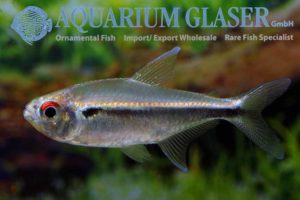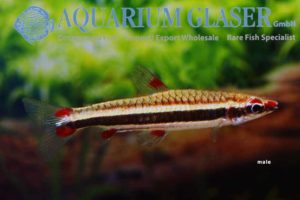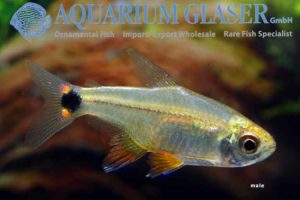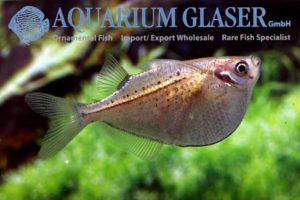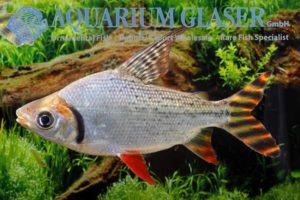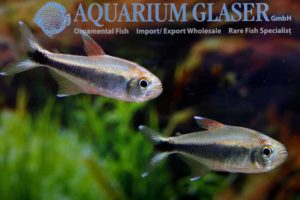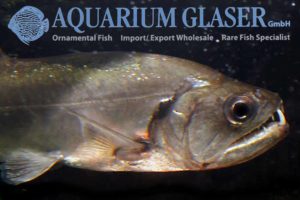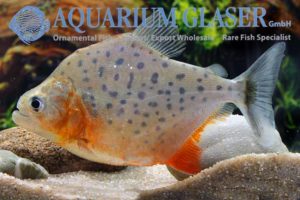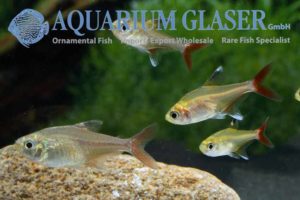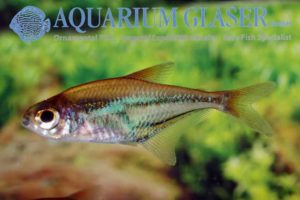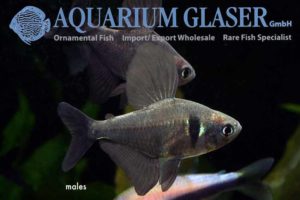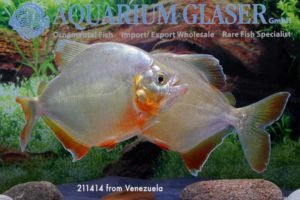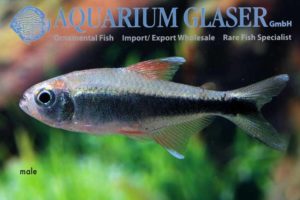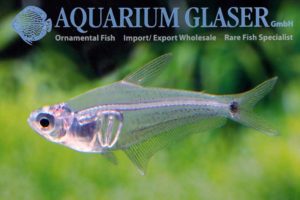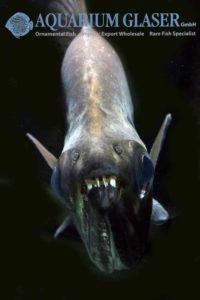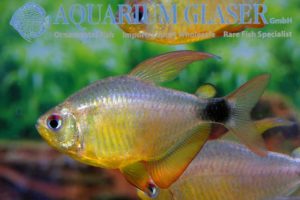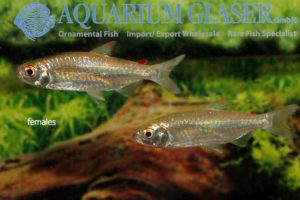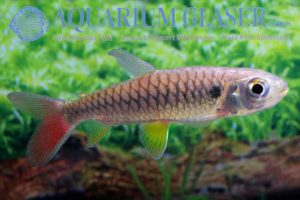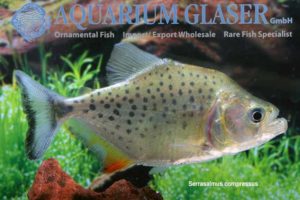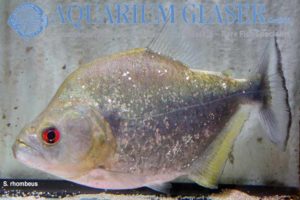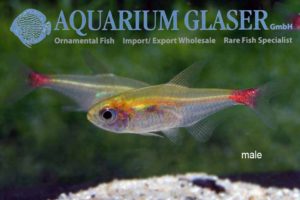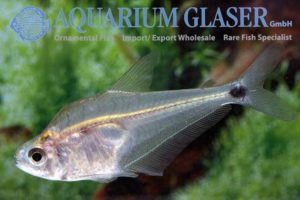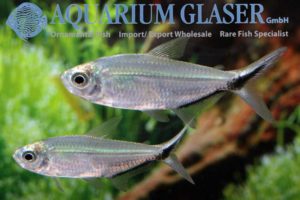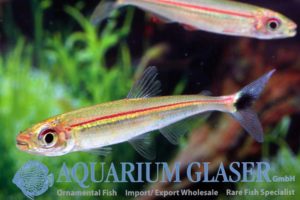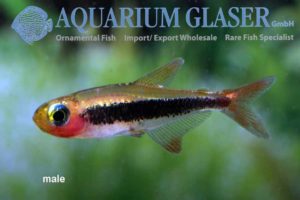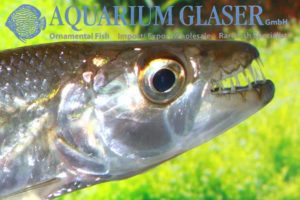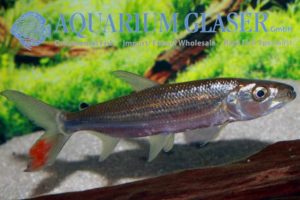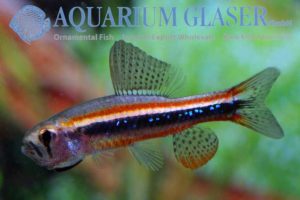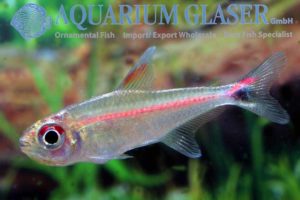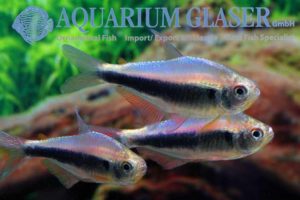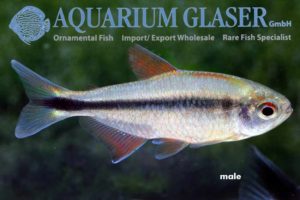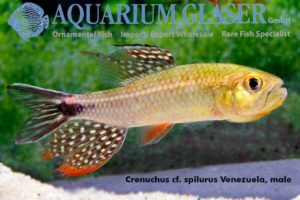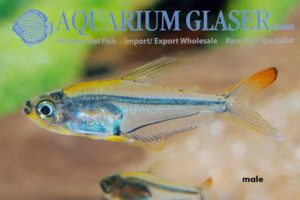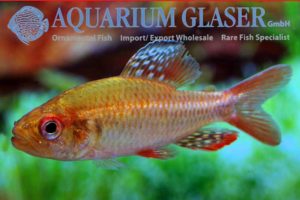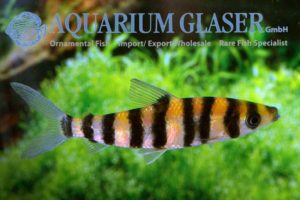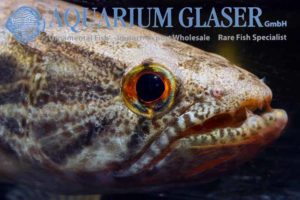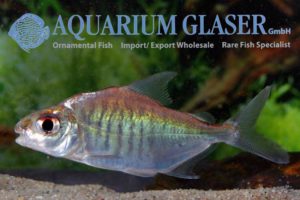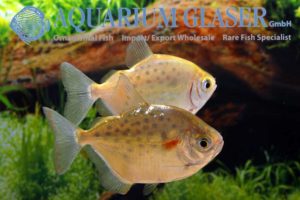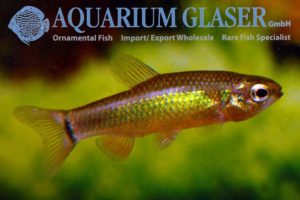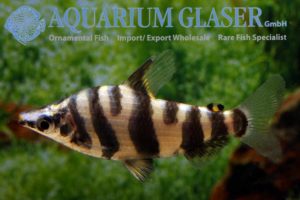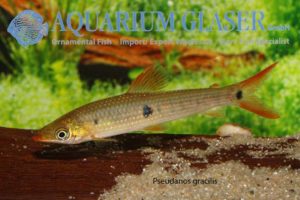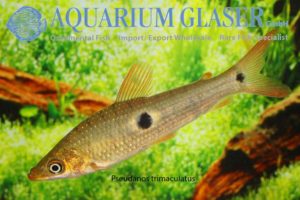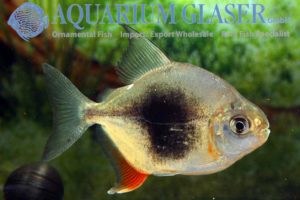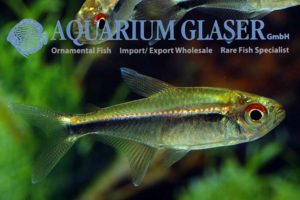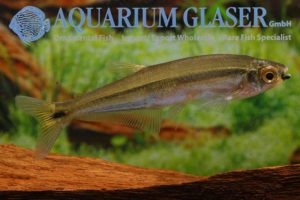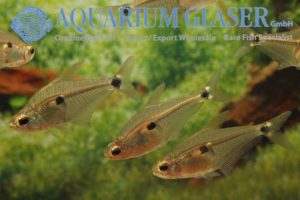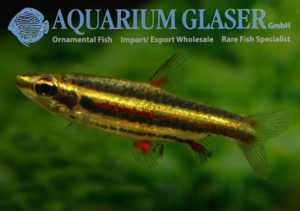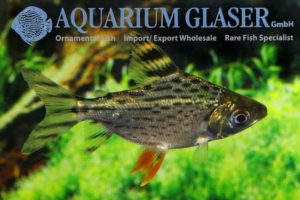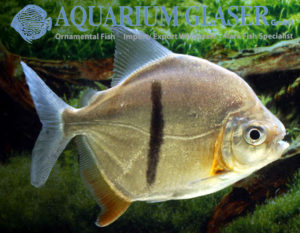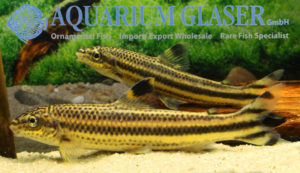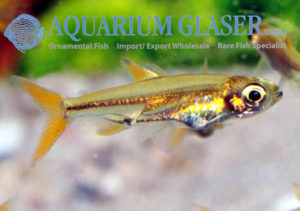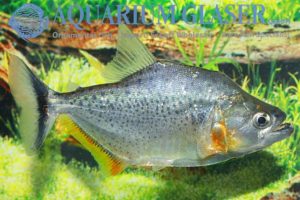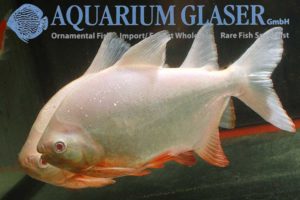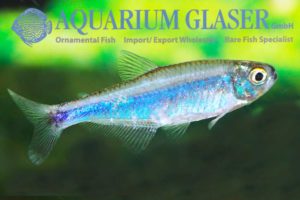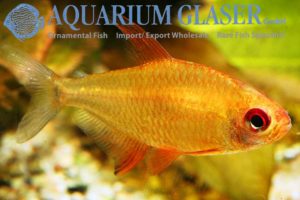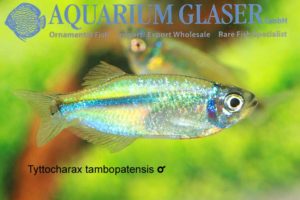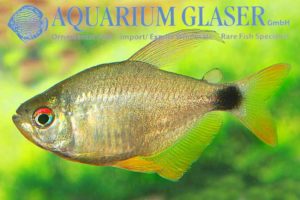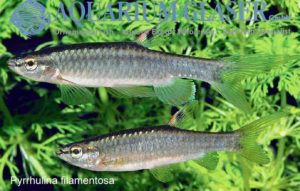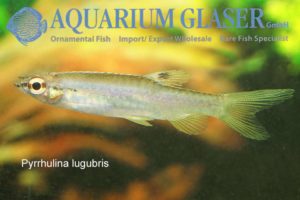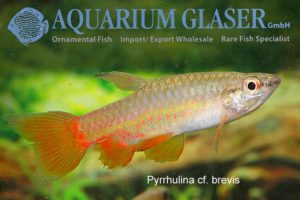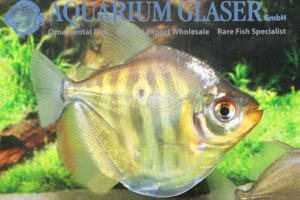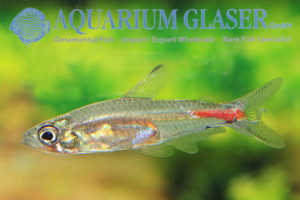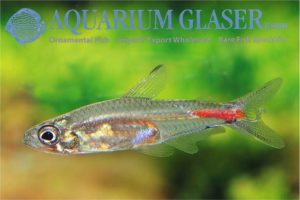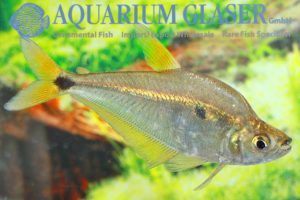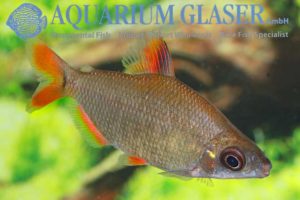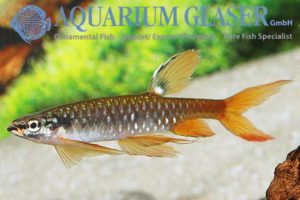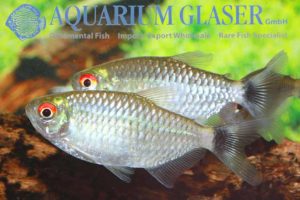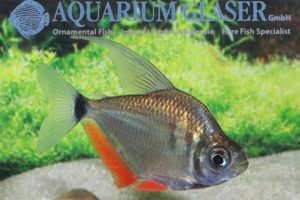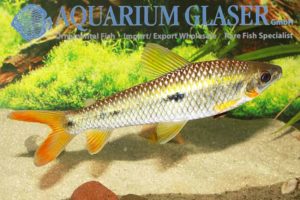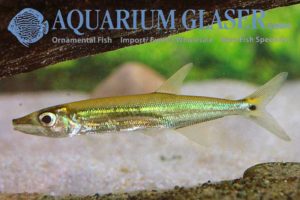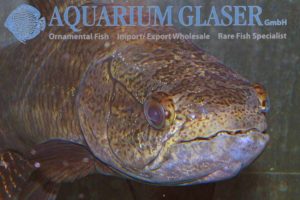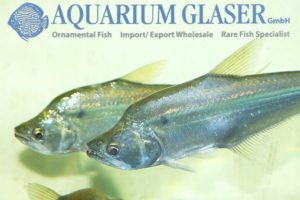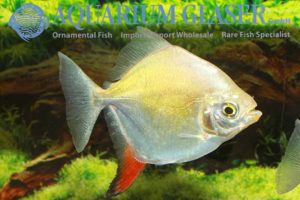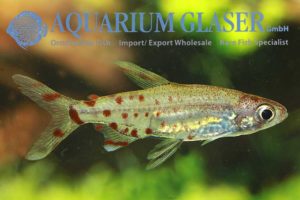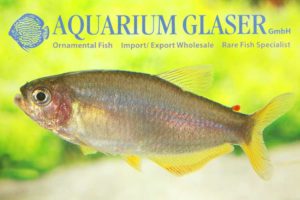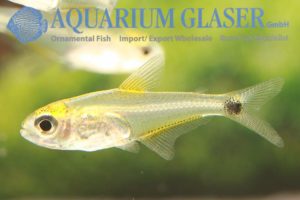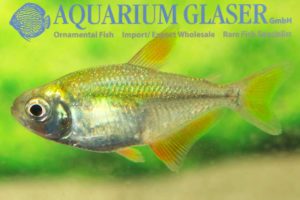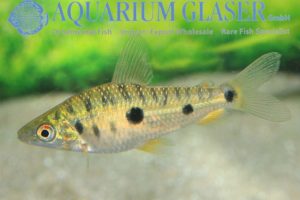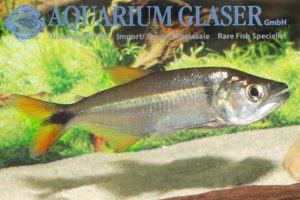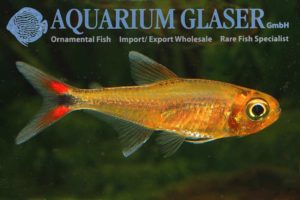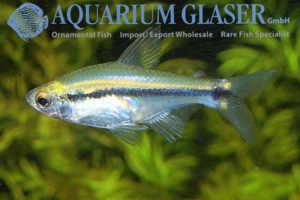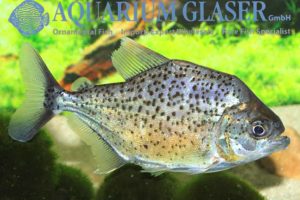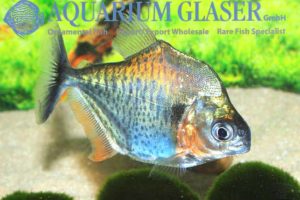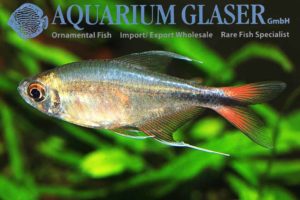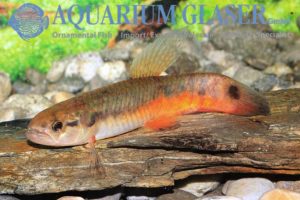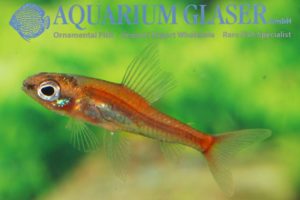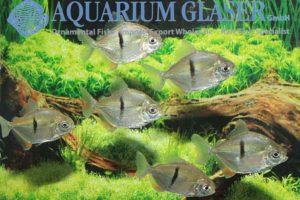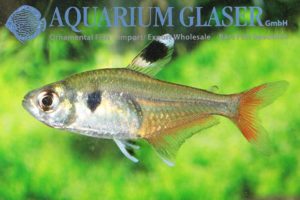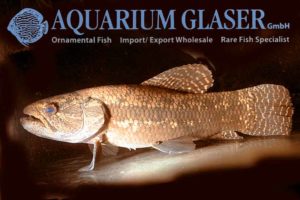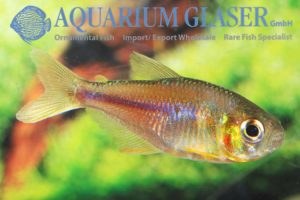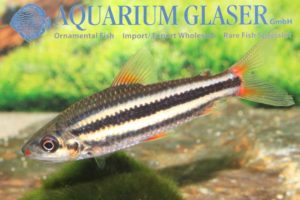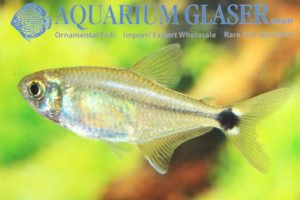Finally we were able to import agin this very pretty, only occasionally available tetra from Peru. Keeping this fish is comparable o the popular Black Neon (Hyphessobrycon herbertaxelrodi) that looks also a bit similar. For further information’s, please see http://www.aquariumglaser.de/en/news/Hyphessobrycon_eschwartzae_Hyphessobrycon_cf_agulha__en/ For our customers: the fish have code 260203 on our stocklist. Please note that wee […]
09. Characoids: tetra relationship (483)
-
-
Nannostomus nigrotaeniatus
This beautiful pencil fish has been described scientifically only a few months ago. It is quite similar to N. trifasciatus, but has a much broader central longitudinal band. The most important visual difference for aquarists is the fact that this species is sexually dichromous. Only the males have the very nice red spots in the […]
-
Serrapinnus sp. aff. kriegi
The tetras which were called “Cheirodon” for decades are splitted now in several genera: Nanocheirodon, Compsura, Odontostilbe, Serrapinnus, and Cheirodon. They all have a generalized pattern with a black caudal spot and light spots above and below it. We currently received a pretty species of that group from Peru. Sadly we were not able to […]
-
Ladigesia roloffi
This beautiful tetra originates from West Africa. The fish becomes only 3-4 cm long. Nevertheless it should be kept in comparatively large aquaria, for it loves to swim a lot. The males can be easily recognized by the shape of the anal fin. The sense of that structure is not researched yet. Text & photos: […]
-
Gasteropelecus maculatus
Hatched fishes belong to very few species of fish that are able to fly. A hatched fish on the run jumps out of the water and uses the pectoral fins just like wings. So these tiny, only 5-6 cm long species can jump several meters. The typical hatched belly is also an adaption for flying, […]
-
Semaprochilodus laticeps
We received wonderful Semaprochilodus from Venezuela. Sadly there was a lot of confusion regarding the correct identification of species of Semaprochilodus in the aquarium literature and in the internet. So S. laticeps – this determination is without doubts correct – is illustrated most often under the names of S. taeniurus (this is a different species […]
-
Hyphessobrycon sp. aff. metae
We received this beautiful tetra fro Venezuela. So far we were not able yet to determine it exactly. For our customers: the fish has code 261352 on our stocklist. Please note the we exclusively supply the wholesale trade. Text & photos: Frank Schäfer
-
Hydrolycus armatus
so interesting from a biological point of view that every aquarist should know them. Currently four species of sabertooth-tetras are distinguished. All have in common extremely large, saber-shaped teeth in the lower jaw that are used to spear other fish. In the upper jaw are holes in the bone that have the function of sheaths […]
-
Serrasalmus cf. neveriensis
There are many enigmatic species of Piranha, but one of the most mysterious ones is S. neveriensis. For the first time ever we could import two specimens from Venezuela, which fit in respect of anatomical features very well with that species that has been described in 1993. The coloration of the fish varies a lot. […]
-
Hyphessobrycon axelrodi
Initially, this charming dwarf tetra was described from the island of Trinidad. The maximum length is 2 cm in males and about 3 cm in females. Now we received a shipment with wild collected specimens from Venezuela. The beautiful animals fit quite good to the description of H. axelrodi, the calypsotetra; the scientist Taphorn determined […]
-
Heterocharax virgulatus
For the first time ever we managed to import this breathtaking species of tetra from Venezuela. The about 4 cm long fish always swim in closely aggregated schools. They settled in our fishhouse without problems, but for the photographer these fish are a real challenge. The brilliant glittering colours – blue, green, violet – […]
-
Megalamphodus megalopterus
Black Phantom Tetra The Black Phantom Tetra belongs to the most common species of fish in the aquarium trade. It originates from the Mato Grosso in Brazil, but all fish in the hobby are bred ones. Wild collected specimens do not appear in the trade, because decades of selective breeding produced so pretty fish that […]
-
Pygopristis denticulata
One could name this fish the ideal piranha for home aquaria. They are very colorful and comparatively peaceful against conspecifics. It is also possible to keep them along with other larger fish species. This piranha is so to say an intermediate between the plant eating pacus and the meat eating piranhas. Although Pygopristis denticulata are […]
-
Hyphessobrycon sp. aff. metae
We could import this pretty tetra from Venezuela. There is no doubt that it represents a close relative of Hyphessobrycon metae. The broad stripe in the caudal fin of our fish is the main difference. For our customers: the animals have code 261352 on our stocklist. Please note that we exclusively supply the wholesale trade. […]
-
Leptagoniates pi
We were able to import once more the very rare crystal glass tetra. The charming species attains a maximum length of only about 4 cm and is very peaceful. For our customers: the animals have code 266002 on our stocklist.Please note that we exclusively supply the wholesale trade. Text & photos: Frank Schäfer
-
Hydrolycus tatauaia
Whosoever asked himself what makes a real good nightmare for small fishes in Amazonia: here is the answer. Hydrolycus tatauaia is a sabertooth-tetra that impales its victims with the extreme long teeth in the lower jaw. These teeth are so long that they have to be placed in special caves in the upper jaw and […]
-
Hyphessobrycon heliacus
We currently have magnificent, large bred specimens of the Kitty tetra in stock. The males already have wonderfully developed dorsal fin “flags”. This species has been confused in the past with Hyphessobrycon lowae, which is a different species. For our customers: the animals have code 261334 on our stocklist. Please note that we exclusively supply […]
-
Micralestes stormsi
We received the rare tetra Micralestes stormsi from Nigeria. the beautiful schooling fish are said to become around 10 cm long, currently our fish have a length of 6-8 cm and are sexually completely differenciated. Male can be recognized by the lappet on the anal fin. For our customers: the fish have code 149004 on […]
-
Chalceus erythrurus
We received bred specimens of this beautiful large tetra – the real one, with bright yellow ventral fins. Currently the fish are 7-9 cm long. For our customers: the animals have code 215003 on our stocklist. Please note that we exclusively supply the wholesale trade. Text & photo: Frank Schäfer
-
Piranhas! Serrasalmus compressus
Another rarity reached us from Peru: Serrasalmus compressus. The systematics of Piranhas are still poorly understood, especially young fish are very difficult to determine. Formerly this species has been often traded as S. hollandi. S. compressus reaches a maximum length of about 20 cm. This species of Piranha are solitary fish that feed in their […]
-
Piranhas! Serrasalmus niger
We received magnificent, 12-15 cm long Serrasalmus rhombeus from Brazil. This species attains a maximum length of about 50 cm and is thus one of the largest species of Piranha. Sometimes occur specimens with a very dark and dull coloration. In our current import we also obtained such a fish. This sport has formerly been […]
-
Hemigrammus stictus
This peaceful and beautiful tetra occurs in the wild along with the Cardinal tetra (Paracheirodon axelrodi). A tank that is inhabited by a school of both species is a wonderful look. We recently received splendid wild collected Hemigrammus stictus. The species attains a length of 4-5 cm. For our customers: the fish have code 257503 […]
-
Roeboides descalvadensis
We received this rare glass predatory tetra from Paraguay. It is an ideal aquarium fish for all who are interested in keeping predatory tetras and have no very large tank, because R. descalvadensis becomes only around 10 cm long. Feeding the fish is pretty easy for they accept almost any type of the usual frozen […]
-
Moenkhausia costae
This tetra originates from Brazil (Rio Sao Francisco and Itapicuru). It reaches a maximum length of about 7 cm. Currently we can offer German bred specimens of this attractive schooling fish. For our customers: the fish have code 268613 on our stocklist. Please note that we exclusively supply the wholesale trade. Text & photo: Frank […]
-
Iguanodectes geisleri
The lizard tetras of the genus Iguanodectes are in general very rare aquarium fish. Currently 8 species are accepted. The very slender fish attain a maximum length of about 7 cm and are peaceful schooling fish. We could import the very pretty Iguanodectes geisleri from Venezuela. This blackwater fish is characterized by the three coloured […]
-
Tucanoichthys tucano
Finally we are able to offer this tiny, very nice and extremely rare dwarf tetra once more. For more information please see http://www.aquariumglaser.de/en/news/Tucanoichthys_tucano_en/. For our customers: the animals have code 298923 on our stocklist. Please note that we exclusively supply the wholesale trade. Text & photos: Frank Schäfer
-
Hydrocynus goliath
The tigerfish of the genus Hydrocynus are the top predators among the freshwater fishes of Africa. H. goliath represents the largest species, maximum length reported so far is more than 130 cm and 50 kg weight. Our specimens currently are 10-12 cm long. Tigerfish are very popular among sport fishers, but aquarists specialized in predatory […]
-
Hydrocynus goliath
Once more we received nice specimens of this gigantic predator from the Congo. For more information on the species, please see http://www.aquariumglaser.de/en/fish-archive/tetras-en/predatory-tetras-en/Hydrocynus_goliath_en/ For our customers: the animals have code 141403 on our stocklist. Please note that we exclusively supply the wholesale trade. Text & photos: Frank Schäfer
-
Poecilocharax weitzmani
Of course this fish is known in the hobby for decades already, but isn´t it nevertheless a breathtaking beauty? The tiny animal is an ideal companion of the cardinal tetra, along with which it occurs in the natural habitat, too. For our customers: the animals have code 281002 on our stocklist. Please note that we […]
-
Bryconops cf. caudomaculatus
For the first time ever we could import this attractive tetra from Venezuela. Currently 12 species of Bryconops are described from Venezuela, but most of them are known from preserved specimens only. So our determination is only tentative. In any case the fish are very pretty; we suppose that they may reach a maximum length […]
-
Hyphessobrycon sp. Red-Blue Peru Tetra
This tetra, which attains a maximum length of about 4-5 cm, is without any doubts one of the most attractive members of the tetra family. Obviously the species has not been described scientifically yet. It originates from Peru, but no details regarding the origin are currently available. Only the future can show, if this fish […]
-
Hyphessobrycon cf. melanostichos
For the first time ever we can offer this attractive new tetra. Our specimens are German bred ones. Hyphessobrycon melanostichos has been described scientifically only in 2006. Until now the fish is known only from the upper reaches of the Rio Tapajos, namely a small river called Rio Doze de Outubro. If our fish are […]
-
Crenuchus cf spilurus Venezuela
Along with the new, red species of Crenuchus that lacks the tail spot (see http://www.aquariumglaser.de/en/fish-archive/tetras-en/south-america-en/A_new_species_of_Crenuchus__en/) we received splendid, large Crenuchus cf. spilurus from Venezuela. Some specimens also have a reddish basic coloration, others are yellowish. Only the males develope the gorgeous sailfins. For our customers: the animals have code 250225 on our stocklist. Please note […]
-
Trochilocharax ornatus
Once more we were able to import the charming, only 2 – 2.5 cm long crystal rainbow tetra from Peru. For more information on the fish, please click http://www.aquariumglaser.de/en/news/The_crystal_rainbow_tetra_has_been_described_Trochilocharax_ornatus_en/ For our customers: the fish have code 258333 on our stocklist.Please note that we exclusively supply the wholesale trade.
-
A new species of Crenuchus!
We were able to import this obviously undescribed species of Crenuchus from Venezuela. This beautiful, reddish tetra is distinguished from the only described species of the genus (Crenuchus spilurus) by the deeper body, the orange-red fins, the only hardly visible caudal spot and the fact that the anal fin in males of the new Crenuchus […]
-
Leporinus sp. aff. tigrinus
This beautiful striped Leporinus originates from the Ventuari river in Venezuela. It represents possibly a still undescribed species of Leporinus; Leporinus with a similar coloration are known so far only from the Rio Tapajos and Rio Xingu in Brazil; these “haresnouts” (this is what the name Leporinus means translated) have been described in 1929 under […]
-
Hoplias cf. teres
For the first time ever we were able to import this trahira from Venezuela. We received only very few specimens. The new species differsfrom all Hoplias imported so far by the brillant coloured eye. However, we are not able to confirm the scientific name of H. teres, a species described by Valenciennes in 1847 from […]
-
Acnodon normani
We are able to import this rare and comparably small (up to 13.5 cm standard length without caudal fin), pretty pacu only very occasionally. This is due to the fact that Acnodon represents a type of fish that lives in open waters. This is also obvious from its typical pattern, consisting of thin vertical stripes […]
-
Metynnis cf. lippincottianus
We received very pretty spotted silverdollars from Brazil. The particular variety is sexually differentiated at a very early stage. In our specimens, which are about 6 cm long, the sexes are already distinguished. The males have an orange spot on the shoulder, shining scales on the back and the outer border border of the anal […]
-
Neolebias ansorgii
This dainty little characin was a fairly popular aquarium fish in the 1950s and 1960s – according to the literature, at least. Nowadays it is only very rarely seen in the trade. The species is comparatively widespread in Central Africa. It has been reported from Angola, Benin, Nigeria, Cameroon, Gabon, and the D. R. Congo […]
-
Abramites hypselonotus
We received very nice Marbled Headstanders in perfect aquarium size (4-6 cm) from Venezuela. The shipment contains a lot of specimens with a very contrasting pattern. For our customers: the fish have code 200502 on our stocklist. Please note that we exclusively supply the wholesale trade. Available in limited numbers only. Text & photo: Frank […]
-
Pseudanos gracilis
On tuesday 28.8.2012 we informed you in our Extra-Newsletter that the rare headstander Pseudanos trimaculatus from Peru had arrived. One of our readers – a specialist in headstanders – informed us kindly that the import contains two species, the rare P. trimaculatus and the even rarer Pseudanos gracilis. Hearty thanks for the hint! We have […]
-
Pseudanos trimaculatus
We received the very rare Threespotted headstander from Peru. The size of the fish is 5-7 cm. For our customers: the fish have code 206103 on our stocklist. Please note that we exclusively supply the wholesale trade. Text & photo: Frank Schäfer
-
Myleus sp. LAMAX III
We are proud to present to you this extraordinary silver dollar (probably an extremly rare sport of M. schomburgki?). It is said that this beauty becomes only 8-9 cm long. For our customers: the fish have code 270903 on our stocklist. Please note that we exclusively supply the wholesale trade. Text & photos: Frank Schäfer
-
Hyphessobrycon eschwartzae (= Hyphessobrycon cf. agulha)
The Flag Tetra (Hyphessobrycon heterorhabdus) belongs to most beautiful small tetras of Amazonia. A sister species, H. amapaensis, occurs in Brazil. It has a similar coloration, but can be recognized by the broad, red stripe. Both species are much sought after. Now we were able to import another species of Flag Tetra from Peru, which […]
-
Piabucus melanostomus
Code: 278934
-
Phenacogaster tegatus
Six eyed tetra We obtained the rare, fascinating Six eyed tetra (Phenacogaster (formerly: Vesicatrus) tegatus) from Paraguay. The peaceful, about 6 cm long schooling fish confuses predatory fish with its pattern. In the middle of the body and on the caudal peduncle P. tegatus has eye-spots; thus it looks like that the fish has three […]
-
Nannostomus marginatus
We already introduced to you a new sport of the dwarf pencil fish from Peru in an Extra-Newsletter this week. We took the opportunity to take a closer look than usual on our “regular” dwarf pencils from Brazil. Honestly – aren ´t they among the most beautiful species of ornamental fish at all? For our […]
-
Semaprochilodus taeniurus
We received very beautiful Flagtail Prochilodus from Colombia. The fish have a perfect size (5-7 cm). Among them is a top rarity: the first xanthoristic (= due to a genetic peculiarity with a yellow-golden instead of a grey basic colour) Semaprochilodus that came to our knowledge! For our customers: the fish have code 290504 on […]
-
Myloplus (formerly: Myleus) schomburgkii WILD
Finally we managed to import again a small number of the beautiful Myloplus schomburgkii from Brazil. Currently the fish are 7-10 cm long; the sexes just start to differentiate externally. In males the anal fin gets an additional konvex lobe. For more information on the species, please check: http://www.aquariumglaser.de/en/fish-archive/tetras-en/silver-dollars-en/Myleus_schomburgkii_en/ For our customers: the fish have […]
-
Leporellus vittatus
Finally we were once more able to import some of the very rarely offered Leporellus vittatus from Brazil. This extraordinary species attains a length of approximately 25 cm and belongs to the headstander tetra relationship. However, in Leporellus the air bladder is mostly reduced and so the fish live strictly bottom orientated. Our animals are […]
-
Ladigesia roloffi
This dwarf tetra (maximum length reported is 4 cm) is a real jewel from Westafrica. The fish love to swim. They should be kept in schools in a well planted aquarium. It is important to choose a dark gravel which makes the colours of the fish shine brightly. For our customers: the fish have code […]
-
Serrasalmus irritans
Finally we managed to import once more this rare piranha in small numbers. For our customers: the fish have code 292284 on our stocklist. Please note that we exclusively supply the wholesale trade. Text & phoros: Frank Schäfer
-
Albino Pacus
For the first time ever we received two albino pacus (Piaractus brachypomus, formerly Colossoma brachypomum) from Colombia. The fish are really beautiful, for the red colours on the body stay even in the albino variety. Currently the fish are 16-20 cm long. Due to the different shapes of the anal fins they seem to represent […]
-
What about a Blue Tetra? Knodus borki
Currently we have wonderful, wild collected large Blue Peru Tetras in stock. This fish was known in the trade for a long time under the name of Boehlkea fredcochui until it was found that this name applies to a total different species. So the Blue Peru Tetra now is called Knodus borki, but it still […]
-
Hyphessobrycon pulchripinnis ORANGE BOLIVIA
For our customers: the fish have code 261634 on our stocklist. Please note that we exclusively supply the wholesale trade. Photo: Frank Schäfer
-
Tyttocharax tambopatensis
Finally we managed to get once more this largest of all Tyttocharax species: it becomes around 2 cm long. We have a limited number of fully grown, very nice specimens in stock. For our customers: the fish have code 298974 on our stocklist. Please note that we exclusively supply the wholesale trade. Text & photos: […]
-
Hyphessobrycon heliacus
We currently have magnificent, large bred specimens of the Kitty tetra in stock. The males already have wonderfully developed dorsal fin “flags”. For our customers: the animals have code 261333 on our stocklist. Please note that we exclusively supply the wholesale trade. Text & photos: Frank Schäfer
-
Pyrrhulina filamentosa
This beautiful Pyrrhulina also reached us recently from Guyana: it can be recognized best by the broad dark lateral band. However, the species has a very wide distibution and we sometimes received them also from Colombia. Maximum size reported for P. filamentosa is 10 cm. So this species is a beautiful, representative aquarium inhabitant. For […]
-
Pyrrhulina lugubris
Regarding the coloration this Pyrrhulina may look a bit inconspicous at the first glimpse, but if one gives the fish a chance to settle down it developes a bright, beautiful pastel. In any other respect this fish is a true Pyrrhulina and enables lots of interesting observations in the aquarium. This species prefers to swim […]
-
Pyrrhulina cf. brevis
This gem from Peru is without any doubt the most colorful species in the genus Pyrrhulina. In breeding mood the males get red-orange fins and on each scale appears a cherry-red spot. One should keep this up to 6 cm long species in larger tanks. Under these conditions it is possible to keep more than […]
-
Mylossoma duriventre
We received a limited number of wonderful specimens of the real Mylossoma duriventre (size: 7 – 10 cm) from Paraguay. For our customers: the fish have code 271204 on our stocklist. Please note that we exclusively supply the wholesale trade. Text & photo: Frank Schäfer
-
Brittanichthys axelrodi
++ Currently (january 2011) a good number of wild collected animals of that species reached us! Code 211902 ++ Every now and then you will find this very sensitive tetra (which is above all prone to stress) among a few specimens of Cardinals Paracheirodon axelrodi. If used to aquarium conditions, however, it is very enduring […]
-
Brittanichthys axelrodi
This wonderful and exotic tetra is only very rarely available. Now we can offer them in top quality and adult, although only in limited numbers. The males can be recognized by the strange glandular scale in the caudal fin. The use of that scale is unknown. Size of the fish: 3-4 cm. For our customers: […]
-
Roeboides araguaito
For the first time ever we have this nice predatory tetra from Venezuela in stock. The largest specimen known so far was 11 cm long (without caudal fin), we have received a limited number of specimens in the sizes 6-8 cm (code 289174 on our stocklist) and 8-10 cm (code 289175 on our stocklist). Please […]
-
Distichodus affinis
Currently we can offer the very rare Distichodus affinis from the Congo in limited numbers. The males have beautiful red fins and stay much smaller than the females (males 5 – 6 cm, females 8 – 10 cm). For our customers: the fish have code 123002 on our stocklist. Please note that we exclusively supply […]
-
Copella arnoldi
Just in: extraordinary beautiful splashing tetras in XXL-size, German bred. For our customers: the animals have code 219554 on our stocklist. Please note that we exclusively supply the wholesale trade. Text & photo: Frank Schäfer
-
Moenkhausia sanctaefilomenae WILD
There are species of fish that are so commonly seen in the trade that we sometimes forget to look at them with the eyes of a child. One of these species is the red eye tetra, one of the top classics among the ornamental fish species They can be found in any pet shop around […]
-
Erythrinus sp. TAHUAYO RIVER
Another recent first importation from Peru: a new species of Erythrinus! It is clearly distinguished from the other two species of Erythrinus known so far from Peru, eg Erythrinus erythrinus (see http://www.aquariumglaser.de/en/erythrinus-erythrinus-_de_1009.html) and E. sp. Madre de Dios (see http://www.aquariumglaser.de/en/erythrinus-sp-madre-de-dios_de_1324.html) by the fine, whiteish-blue seam on the caudal fin. Our specimens are still too small […]
-
Tetragonopterus argenteus
Code 266004
-
Leporinus brunneus
For the first time ever we were able to import this beautiful, large tetra from Venezuela. The fish can reach a maximum size of 25-30 cm. It can be found in the basins of Orinoco river and the rio Negro. The coloration of the fish is quite variable, depending on the origin. The orange spot […]
-
Acestrorhynchus cf. minimus
The barracuda tetras (Acestrorhynchus) from South Americ are beautiful predators, which are much sought for among specialized aquarists with large tanks. Several of the approximately 14 species accepted currently become 20 to 40 cm long, but there do exist also small species in the genus that become never larger than 10 cm. We received from […]
-
Holpias curupira
Code: 258606
-
Cynopotamus atratoensis
It is a very rare occasion that predatory tetras of the genus Cynopotamus are imported, due to their sensibilty against stress and transportation. So we are extremely happy and prous that we have been able to manage an importation of not less than eight specimens from Venezuela. The fish have a size of 18-22 cm […]
-
Myleus rubripinnis
We received magnificent M. rubripinnis from Venezuela, which we call “sp. rubripinnis RED” due to their intensive red colours. Code: 270392. Our specimens are 4-7 cm long. Please note that we exclusively supply the wholesale trade. Text & photos: Frank Schäfer
-
Lepidarchus adonis
Currently we have this beautiful and extreme rare dwarf tetra (maximum length: 3 cm) in good numbers in stock. Code: 145303. Please note that we exclusively supply the wholesale trade.
-
Rachoviscus crassiceps
Finally we are able to offer once more this beautiful, but sadly only very occasionally available tetra. However, even now we have only a limited number of them. Although the fish is really beautiful – one of the most attractive features is the deep red adipose fin – this is not the main excitement for […]
-
Characidae gen. sp. “Yellow Glass Tetra”
For the first time ever we were able to import this charming dwarf tetra from Peru, which cannot be placed in any known genus or species so far. Our largest specimens are about 1.5 cm long. Of course it is possible that our fish represent only juveniles of a larger species, but this thesis seems […]
-
Gymnocorymbus socolofi
The genus Gymnocorymbus comprises only three species, one of which – the Black Skirt tetra, G. ternetzi – is among the most popular ornamental fish. The other two species are absolute rarities. So we are glad to be able to offer one of them, the rare Gymnocorymbus socolofi from Colombia, once more. This tetra reaches […]
-
Leporinus steyermarki
Leporinus steyermarki is a beautiful large tetra. It can reach a maximum size of about 30 cm and originates from Venezuela. In German, the fish is now and then named “Grey Leporinus” which is for sure not describing accurately the coloration of the animal. Maybe this name bases on a confusion with another of the […]
-
Oligosarcus jenynsii
This pretty predatory tetra is only imported very occasionally to Europe, although the up to 30 cm long species is quite common in the southern parts of South America (Argentina, Brazil, Paraguay, Uruguay). The photographed specimen originates from Paraguay. Basically speaking, Oligosarcus is nothing else but a Banded Astyanax (Astyanax fasciatus) that has been developed […]
-
Hasemania sp. Orange
After a long time we were able now to import once more this beautiful tetra from Peru. It was not possible so far to place it in a known genus or described species. We chose the name “Hasemania” only because the basic coloration of the fish is somewhat reminescent to that of the well known […]
-
Serrapinnus sterbai (=7 Rays Mint Tetra)
We imported this new, very nice and interesting tetra for the first time now from Brazil. Obviously this species originates from the Araguaia/Tocantins basin in Central Brazil. In the most current issue of the German aquarium magazine “Amazonas” (Issue 35, May/June 2011, p. 79) this fish is named “7 Rays Mint Tetra” what is adopted […]
-
Pristobrycon striolatus
For the first time ever we succeeded in importing this unique species of piranha from Brazil. Currently the piranhas are placed in 5 genera (Catoprion, Pristobrycon, Pygocentrus, Pygopristis, and Serrasalmus). However, there is some discussion about this classifaction, because intermediate forms have been observed. The species currently placed in Pristobrycon are quite discoid fish as […]
-
Serrasalmus eigenmanni Peru
Serrasalmus eigenmanni Peru This medium sized and very interesting piranha (maximum length reported is around 20 cm) was imported from Peru. This is worth mentioning, as so far S. eigenmanni has been “only” reported from Brazil, the Guyanas, and Venezuela. Our determination bases on the work by Jégu & Santos (1988). Following these authors, the […]
-
Hemigrammus filamentosus (= Hyphessobrycon cf stegemanni Phenix tetra)
Once more we can offer currently this beautiful new dwarf tetra as German bred. At the time we received the fish for the first time it was still undescribed scientifically. The most similar known species was Hyphessobrycon stegemanni. The latter, however, does not have the beautiful long filaments on the fins. In the meantime our […]
-
Erythrinus sp. Madre de Dios
Finally we were successful and imported a larger number of this wonderfully coloured predatory tetra from Peru. Both sexes have the splendid orange belly. Females can be recognized by the shape of the ventral fins: they are comparatively small and rounded (large and pointed in males). It is said that the species can attain a […]
-
Odontocharacidium cf aphanes
Once more we were able to import this cute dwarf tetra from Peru. The maximum length of the fish is around 2 cm total length. Despite their small size the males can be very aggressive against each other. If one can keep a lot of them together they are peaceful (the same phenomenon can be […]
-
Myloplus (formerly: Myleus) schomburgkii
Currently we have one of the most beautiful of the large tetras in stock: Myloplus schomburgkii. The magnificent species reaches up to 45 cm in total length, our specimens have the ideal size of 5-7 cm. The photos of the juveniles illustrating this entrance are made from our specimens in stock, while the adults have […]
-
Pseudopristella simulata
Code: 285513
-
Hoplias curupira
Code 258608
-
Hyphessobrycon itaparicensis
Code: 261203
-
Leporinus arcus
Currently we were able to organize one of the rare imports from Guyana and so we have the beautiful Leporinus arcus originating from there in stock again. The genus Leporinus contains almost 100 species and is thus pretty big. Nevertheless only very few species could establish themselves as aquarium inhabitants. Most of them become quite […]
-
Hyphessobrycon luetkeni
Code: 259823
Red Tail Barracuda Tetra

We received the colorful Acestrorhynchus falcatus from Brazil recently. The graceful predators reach a length of 30 – 40 cm.

For our customers: the fish have code 201703 on our stocklist. Available in limited numbers only! Please note that we exclusively supply the wholesale trade.
Text & photos: Frank Schäfer
Two beautiful Pyrrhulinas from Peru

We received the very rare Pyrrhulina vittata and the similar, also very beautiful Pyrrhulina spilota from Peru. Both species do not only look very nice, but also have a fascinating behavior, for the males take care for the eggs and brood!

Pyrrhulina vittata becomes only 3.5 to 4 cm long and is one of the smallest members of the genus, P. spilota becomes around 7 cm long.

For our customers: P. spilota has code 286784, P. vittata code 286733 on our stock list. Please note that we exclusively supply the wholesale trade.
Text & photos: Frank Schäfer
A new sport of Nannostomus marginatus!

We received this new variety of the dwarf pencil fish from Peru – or does it even represent a new species? Available in limited numbers only!

For our customers: the fish have code 272094 on our stocklist. Please note that we exclusively supply the wholesale trade.

Text & photos: Frank Schäfer
Rummy nose tetras and Cardinals: German bred ones available!

We have received large and healthy German bred Rummy nose tetras and Cardinals. The photos are made from our fish we currently have in stock!

For our customers: the Rummy noses have code 257203, the Cardinals 216555 on our stocklist. Please note that we exclusively supply the wholesale trade.
Text & photos: Frank Schäfer
Fantastic tetras: German bred!

We received this week German bred Moenkhausia cosmops and Hyphessobrycon haraldschultzi. These fish are very strong, healthy and have brilliant colours. Of course we have only limited quantities of these rare fish available… Read more about the species under http://www.aquariumglaser.de/en/news/Moenkhausia_cosmops_en/ (Moenkhausia cosmops) and http://www.aquariumglaser.de/en/fish-archive/tetras-en/hyphessobrycon-hemigrammus-moenkhausia-en/Hyphessobrycon_haraldschultzi_spec_Araguaia__en/ (H. haraldschultzi).

For our customers: M. cosmops has code 268644, H. haraldschultzi 260404 on our stocklist. Please note that we exclusively supply the wholesale trade.
Text & photos: Frank Schäfer
The Phenix tetra has been described: Hemigrammus filamentosus

We introduced this beautiful new tetra to you in May this year under the provisional name of Hyphessobrycon cf. stegemanni.
Now the species has been described scientifically under the name of Hemigrammus filamentosus.
The original description can be downloaded here: http://www.vertebrate-zoology.de/vz61-1/01_Vertebrate_Zoology_61-1_Zarske.pdf
Read more about the fish on our homepage here: http://www.aquariumglaser.de/en/fish-archive/tetras-en/hyphessobrycon-hemigrammus-moenkhausia-en/Hemigrammus_filamentosus_Hyphessobrycon_cf_stegemanni_Phenix_tetra__en/
Lexicon: Hemigrammus: ancient Greek, means “with half line”, referring to the incomplete lateral line, which is genus-specific. filamentosus: Latin, means “with threads”.
Text & photo: Frank Schäfer





